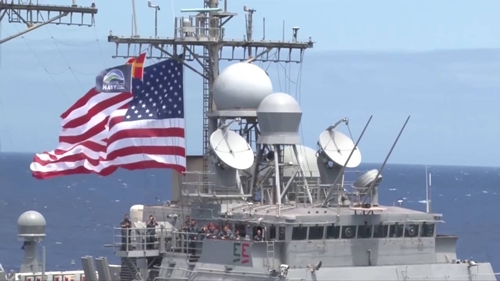The United States has withdrawn an invitation to China to participate in the world's largest international maritime warfare exercise, the Pentagon announced, citing Beijing's "destabilising behaviour" in the South China Sea and signalling fresh strain in bilateral ties.
“As an initial response to China’s continued militarisation of the South China Sea we have disinvited the PLA Navy from the 2018 Rim of the Pacific” exercises, Lieutenant Colonel Christopher Logan, a Pentagon spokesman, said in a statement on Wednesday.
Held every two years and based in Hawaii, the Rim of the Pacific exercise (RIMPAC) involves more than 20 countries from across the world, including Australia, India, Japan and the United Kingdom.
The exercise was established in 1971 by the US, Australia and Canada and has included the armed forces of nations including China. This year, Brazil, Sri Lanka and Vietnam are to take part in the biennial exercises that unfold near the Hawaiian Islands and off the coast of California.
The decision to withdraw the invitation to the People's Liberation Army Navy (PLAN) this summer was made by US Defense Secretary James Mattis in coordination with the White House, according to a US official, after Beijing's recent deployment of missile systems and the first landing of a Chinese strategic bomber on an island in the South China Sea.
Asserting that the US is committed to a free and open Indo-Pacific, the Pentagon said China's continued militarisation of disputed features in the South China Sea only serve to raise tensions and "destabilise" the region.
“We have strong evidence that China has deployed anti-ship missiles, surface-to-air missile systems, and electronic jammers to contested features in the Spratly Islands region of the South China Sea,” Logan said in the Pentagon statement. “China’s landing of bomber aircraft at Woody Island has also raised tensions.
"While China has maintained that the construction of the islands is to ensure safety at sea, navigation assistance, search and rescue, fisheries protection and other non-military functions, the placement of these weapon systems is only for military use," he said.
“China’s continued militarisation of disputed features in the South China Sea only serve to raise tensions and destabilize the region.”
China, which claims much of the South China Sea, one of the world’s busiest shipping routes, has bolstered its military presence by building artificial outposts on reefs. That has led to fears of armed conflict.
Vietnam, the Philippines, Malaysia, Brunei and Taiwan have counter claims which have also been rejected in international arbitration. The strategic South China Sea is rich in energy reserves, fishery resources and is a busy shipping route.
Last year, China warned an American warship, the guided-missile destroyer Dewey, to leave waters it claims in the South China Sea. The Chinese had built an airfield on a reef in the area.
China’s foreign minister, Wang Yi, who was visiting Washington, told reporters at the State Department that “we hope the US will change such a negative mindset”.
Wang, who had been meeting with US secretary of state Mike Pompeo, added, “Both China and the US are big countries, and we’re well-positioned to have greater cooperation at sea.”
Asked about the dispute, Pompeo said, “State Councilor Wang and I spoke about it.” He added that “we’ve expressed consistent concern about militarisation in the South China Sea, and I will leave it to our militaries to talk about their efforts together”.
The Pentagon called on China to remove the military systems immediately and to reverse course on the militarisation of the disputed South China Sea features.
"We believe these recent deployments and the continued militarisation of these features is a violation of the promise that President Xi made to the United States and the World not to militarise the Spratly Islands," Logan said.
On the militarisation in the South China Sea, Wang said, "China is only building civilian and some necessary defense facilities on its own islands.
"That is the right to self-defence and preservation of every sovereign state. It is a normal deployment and has nothing to do with militarisation, just like the US has military presence in Hawaii, in Guam."
China said last week that it landed long-range bombers for the first time on an island in the South China Sea, the latest in a series of manoeuvres putting Beijing at odds with its neighbours and Washington over China's growing military presence around disputed islands.














.jpg)






.jpg)









